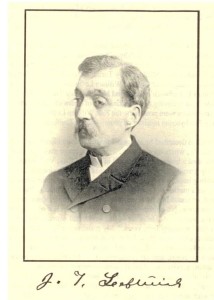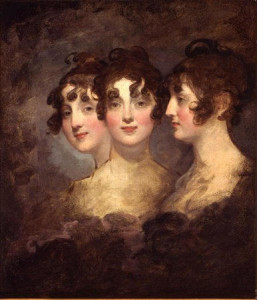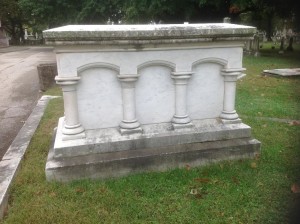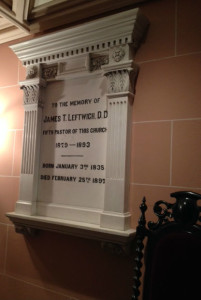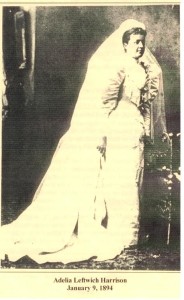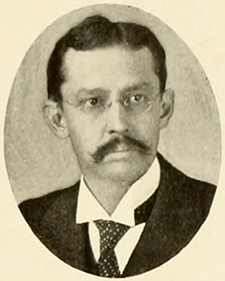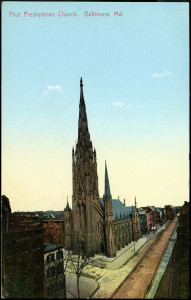My Baltimore Roots – Part 2
In 1879 my great-great-grandfather, The Rev. Dr. James Turner Leftwich became the 5th pastor of First Presbyterian Church of Baltimore, First & Franklin Presbyterian Church as it is called today, for fourteen years. In his first year at the church, my great-great grandfather James got to know and ministered to Elizabeth “Betsy” Patterson Bonaparte until her death on April 4, 1879.
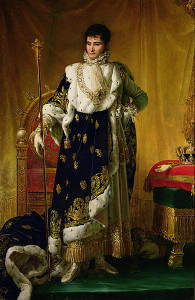 In gratitude to my great-great grandfather, Betsy Bonaparte left a special gift to my great-grandmother Adelia, who was 11 years old at that time. The gift was a string of lapis lazuli beads. From an article written by my aunt Kitty in The Leftwich Heritage, my great-grandmother Adelia would pass the gift on to her daughter–in–law, Katherine early on in her marriage. In a letter dated December 7, 1930 great-grandmother Adelia wrote to my grandmother, Katherine: “When you open the little box there, ask that man who lives in your house [my grandfather] to tell you about Madame Bonaparte, Jerome’s young wife, soon abandoned by Jerome at Napoleon’s mandate. She died in Baltimore with only my dear Father [James Turner Leftwich], & this little gift in the box was given me by the old maiden lady with whom poor Betsy Patterson Bonaparte boarded & where she died. Very romantic & you will know how to value the gift.”
In gratitude to my great-great grandfather, Betsy Bonaparte left a special gift to my great-grandmother Adelia, who was 11 years old at that time. The gift was a string of lapis lazuli beads. From an article written by my aunt Kitty in The Leftwich Heritage, my great-grandmother Adelia would pass the gift on to her daughter–in–law, Katherine early on in her marriage. In a letter dated December 7, 1930 great-grandmother Adelia wrote to my grandmother, Katherine: “When you open the little box there, ask that man who lives in your house [my grandfather] to tell you about Madame Bonaparte, Jerome’s young wife, soon abandoned by Jerome at Napoleon’s mandate. She died in Baltimore with only my dear Father [James Turner Leftwich], & this little gift in the box was given me by the old maiden lady with whom poor Betsy Patterson Bonaparte boarded & where she died. Very romantic & you will know how to value the gift.”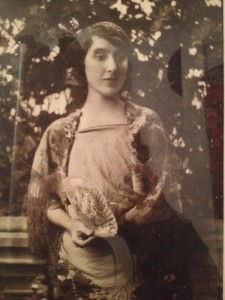
This is is my grandmother Katherine Evelyn (Boone) Harrison, for whom I am named and the beneficiary of the lapis lazuli beads given to Betsy Bonaparte by Jerome Bonaparte. My grandmother is looking very Downton Abbey-ish as the photo was taken in the 1920’s.
In A BAKER’S DOZEN OF HISTORICAL MINUTES FROM THE 225TH ANNIVERSARY OF THE FIRST AND FRANKLIN STREET PRESBYTERIAN CHURCH OF BALTIMORE, MARYLAND, JAMES F. SCHNEIDER writes: “According to her wishes, Madame Bonaparte’s funeral was private. There were no flowers. The Rev. James Turner Leftwich of First Church, of which she remained a lifelong member, conducted the services. She was buried in Greenmount Cemetery, near the resting place of another First Church family, the Hall Harrises, under a tomb that is said to be a replica of Napoleon’s grave on the island of St. Helena. And as her epitaph, Betsy Patterson Bonaparte chose to paraphrase a line from Shakespeare’s Macbeth; ‘After life’s fitful fever, she sleeps well.’”
About two Octobers ago my aunt Katherine (Kitty) and I went out to Greenmount Cemetery for the first time to see where our kinsman had buried Betsy Patterson Bonaparte. While we were there I took some photos of the grave. 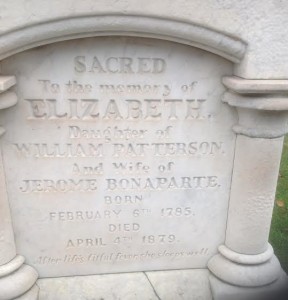
My great-great-grandfather James was by all accounts a splendid and moving orator. He had the gift! There are a number of descriptions about his passionate and elegant sermons including an interesting account of his process. In A Brief History of the First Presbyterian Church of Baltimore, William Reynolds writes: “His method of preparing his sermons was peculiar. Although every one of them was carefully studied out and prepared before hand, it was never committed to writing until the day after its delivery, when he generally wrote it out in full to preserve it for future reference when he should have occasion to refer to the same subject another time. He once stated in the presence of the writer that he never could preach the same sermon the second time. He said that he knew that some of his brethren had sermons that they preached over and over again with great effect but added: ‘I cannot do it. I feel that every sermon I preach must be prepared with special reference to the audience to whom and the occasion upon which it is to be delivered.’ He had but one test he always applied when discussing the sermons which distinguished ministers from time to time delivered in his pulpit. He would say, ‘What lesson was that sermon designed to teach and how did it teach it?’ This test which he applied to the sermons of others was the same to which he subjected his own.”
In the last years of his pastorate, James suffered from failing eyesight and debilitating illness. He was treated at various hospitals in different places including Johns Hopkins where he was under the care of the renowned physician William Osler. James would eventually spend his last days at his son’s home in Atlanta.
My aunt Kitty quotes Dr. John H. Garner, Jr. in his book, The First Presbyterian Church of Baltimore: A Two-Century Chronicle: ” He [James Turner Leftwich] was a theologian preeminently and a preacher of remarkable power. Testimony to his eloquent sermons comes to us from many people. It was unfortunate that his health failed after a decade so that repeated visits to Johns Hopkins Hospital were necessary and often he preached and visited his people while suffering severe pain and carrying his work only with the greatest difficulty. He was a man of fine sensibilities and soon endeared himself to his congregation and to his brethren in Presbytery…The life of the church moved forward well under his pastorate.”
While attending Johns Hopkins University as a graduate student in Baltimore in 1888, my great-grandfather Dr. Thomas Perrin Harrison was hard at work on his dissertation entitled “The Separable Prefixes in Anglo-Saxon.” He also met and fell in love with my great-grandmother Adelia Lake Leftwich. They were married on January 9, 1894
None of my relatives were from Baltimore nor did they settle here. However, it is interesting that via my great-great-grandfather’s pastorate at First Presbyterian Church of Baltimore a relationship was formed, a marriage and then children, grandchildren and great-grandchildren of which I am one. Perhaps this is why I have often felt a kinship with Baltimore even before knowing why I would feel such a connection. Rooted!
When I moved to Baltimore 16 years ago First and Franklin Presbyterian Church was one of my main landmarks to help me get around the city. The church, located at West Madison Street and Park Avenue in the Mount Vernon area, boasts the tallest steeple in Baltimore at 273 feet (83 m). The Gothic wonder was begun in 1854 and completed in 1875, four years before my great-great-grandfather became pastor there. It is a wondrous structure, and I imagine it was quite imposing yet perhaps comforting to Baltimore residents in the 1870’s and onward. My feeble attempts at getting a good photo of the church have been frustrating, so I left it to the experts. This is an unnamed postcard from the 1920’s. It really gives perspective of how stunning the church is.
The most beautiful photographs of the church were taken by the Baltimore Sun’s photojournalist, A. Aubrey Bodine who worked at the paper from 1920 to 1970. From what I gather, he lived in a house or apartment near First Presbyterian Church. He got to know the different angles and character of the church by studying and photographing it. His other photographs are superb and unique, but his images of the church are special, to me. There is something very personal about these photographs. A. Aubrey Bodine was an artist and just as much 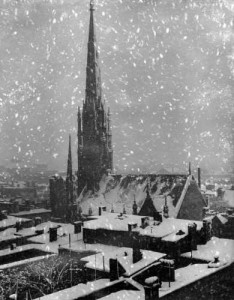 of a composer as Rachmaninoff or Copland. His images are musical and energetic. I got to know A. Aubrey Bodine’s work by chance. Years ago I was shopping for Christmas Cards and came across his various photographs of First Presbyterian Church . I have just a few cards left which I hoard and occasionally send to family related to the Leftwiches.
of a composer as Rachmaninoff or Copland. His images are musical and energetic. I got to know A. Aubrey Bodine’s work by chance. Years ago I was shopping for Christmas Cards and came across his various photographs of First Presbyterian Church . I have just a few cards left which I hoard and occasionally send to family related to the Leftwiches.
This magical, snow filled photograph was taken in 1942, 63 years after my great-great-grandfather James Turner Leftwich began his pastorate at the church.
Photograph by A. Aubrey Bodine – Copyright Jennifer B. Bodine


